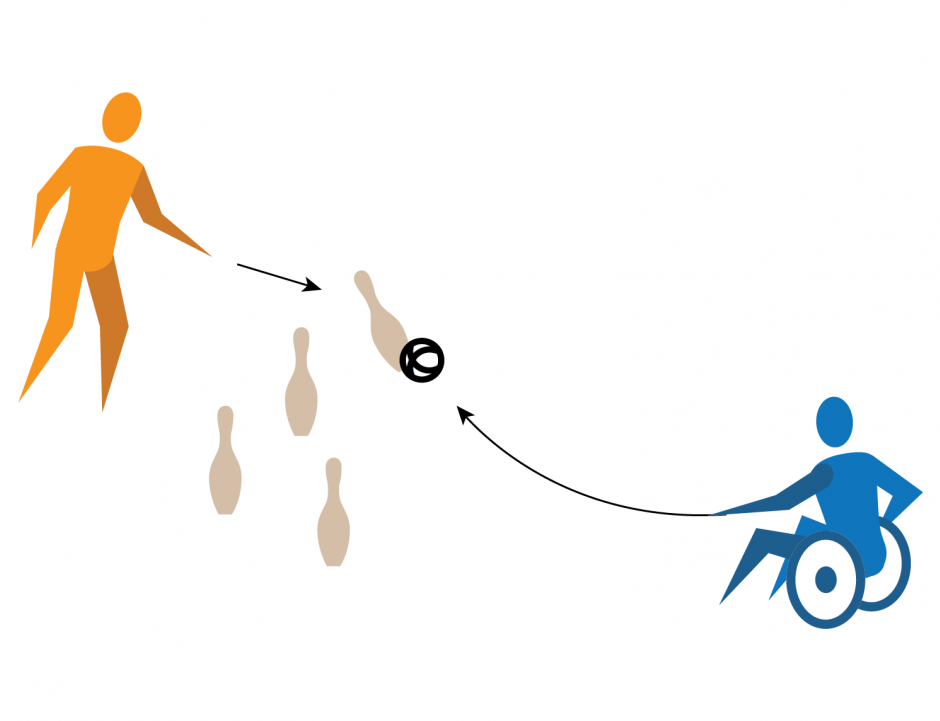TGfU Category: Target Games
Locations: gymnasium, multipurpose room, outdoor space (e.g., field, tarmac)
Game/Sport Connections
Target games are activities in which players send an object toward a target while avoiding any obstacles. By playing these games, participants develop skills and tactics to play other target games or games that require the application of similar skills, concepts, and strategies (e.g., archery, bocce, bowling, croquet, curling, golf, horseshoes, shuffleboard, Snow Snake).
Activity Overview
Participants learn about and practise sending an object to knock down a variety of targets.
Key Movement Skills, Concepts, and Strategies
Throughout the activity, consider highlighting the following skills, concepts, and strategies for effectively sending an object toward a target. Note that this list is not exhaustive and further learning opportunities may arise during the task.
Movement Skills and Concepts
- Manipulation skills and effort awareness: applying a controlled force to send an object toward a target (e.g., being able to control how forcefully the arm/foot swings to increase accuracy of hitting targets at different distances).
- Body awareness: knowing how parts of the body are moving and how to combine and control body movements when sending an object toward a target (e.g., arm/foot following through and pointing where the participant wants the ball to go).
Movement Strategies
- Applying appropriate skills to send an object to improve control and accuracy (e.g., keeping the target in view, following through toward the target).
- Making decisions about which object to use to be successful at knocking down the target (e.g., choosing a big object to send when trying to knock down a small target).
Considerations
- Incorporate some or all of the variations listed in the “Variations” section while planning the activity. This will help to best meet the diverse backgrounds, identities, needs, and interests of participants and maximize the fun, inclusion, participation, and success of everyone.
- To elevate participant voice and choice, periodically pause the activity and share the variations with participants. Ask them to determine how they would like to change the activity to maximize the fun, inclusion, meaningful participation, and success for everyone. Encourage participants to add any variations of their own.
Equipment
- 1 cone per pair
- 1 object to send per pair (e.g., various sizes and textures of balls, beanbag, disc, rubber chicken)
- 4 targets per pair (e.g., pylons, plastic bottles, water bottles, bowling pins)
Safety
- Inspect the equipment and activity area to identify and remove hazards. Check that the activity surface provides sufficient traction.
- Establish the boundaries for the designated playing area at a safe distance from walls and obstacles. Share the boundaries with participants.
- Review the safety rules and activity instructions with participants prior to the activity.
- Instruct participants to be aware of their surroundings, including the locations of other participants during play.
How to Play
- Divide participants into pairs.
- Each pair chooses 4 objects to act as targets (e.g., pylons, plastic bottles, water bottles, bowling pins) and 1 object to send (e.g., various sizes and textures of balls, beanbag, disc, rubber chicken).
- Assign pairs to a space within the playing area.
- One participant sets up 4 targets at various distances in their assigned space while the other participant holds the object. Participants agree on a sending line and mark it with the cone. Participants can agree to increase or decrease the distance between their sending line and their targets at any point during the game.
- The participant who sets up the targets identifies which target they want their partner to hit.
- The participant with the object sends it (e.g., roll, underhand throw, kick with the object maintaining contact with the ground) toward the selected target.
- If the participant knocks down a target other than the selected one, their partner resets that target and the participant with the object tries again.
- If no targets are knocked down, the partner retrieves the object and the sender tries again.
- Participants change spots after 3 attempts at hitting the selected target so the partner who set up the target gets a turn at sending the object.
- This process continues until the chosen target is knocked down. The participant who set up the targets selects another target to hit.
- Participants work together to try to knock down all 4 targets.
- After a period of play, provide participants with some or all of the variations. Ask them to decide how they might change the game to enhance their fun, challenge, and success. Encourage participants to add any variations of their own.
- Consider having groups share their variations and select another variation to try with their group.
Image: Visual Depiction of the Activity Instructions

Pause for Learning
Throughout the activity, ask open-ended questions to help participants refine their movement skills, strategies, and tactical solutions. Examples include:
- Which target was the easiest for you to knock down and why?
- If you chose a target that was too difficult or too easy for your partner to hit, did that change your enjoyment of the activity? Why?
- How did you come up with a distance and an order for hitting the targets that created the best challenge and the most fun?
- Which games or sports have you played or know about that use similar rules and strategies to the ones used in this game?
Variations
- Increase or decrease the distance between the sending line and the target.
- Use only large targets (e.g., pylon, large water bottle).
- The participant sending the object chooses which target they would like to try to knock down.
- Increase or decrease the spacing between the targets.
- Use the non-dominant hand/foot to send the object.
- Use an implement for striking (e.g., soft foam paddle, scoop, pool noodle) to send the object.
- Roll the object down a ramp.
- Place an obstacle between the sending line and the target.


